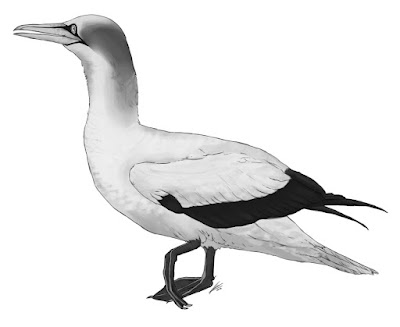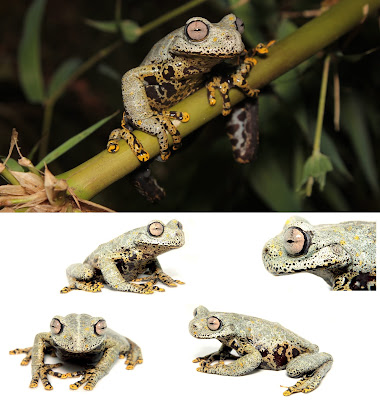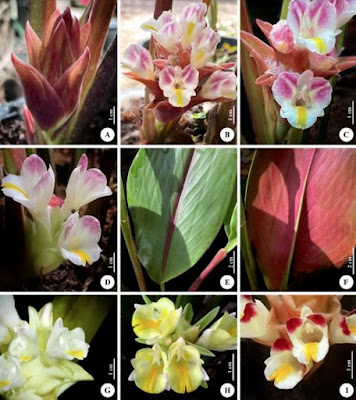[Most Recent Entries] [Calendar View]
Friday, January 20th, 2023
| Time | Event | ||
| 1:07a | [PaleoOrnithology • 2023] A Marine Bird (Aves: Sulidae) from the Langhian (middle Miocene) of Penedo Beach (Setúbal Peninsula—SW Portugal) and Its Paleoenvironmental Context
Abstract The fossil remains of birds from the Miocene of Portugal are scarce, encompassing a total of twelve specimens, from nine paleontological outcrops located in Leiria (central Portugal), southern sector of Setúbal Peninsula and along the lower Tagus Basin. This study focuses on a new specimen found in the Praia do Penedo Norte (Sesimbra) coastal cliff corresponding to a coracoid bone, attributed to Morus sp., a sulid bird, biostratigraphically framed by calcareous nannofossils within the middle Miocene (Langhian). Keywords: Langhian, Morus, Marine environment, Sesimbra AVES Linnaeus 1758 SULIFORMES Sharpe 1891 SULIDAE Reichenbach 1849 MORUS Vieillot 1816 MORUS SP. Olson and Warheit 1988 Discussion and conclusion: The broken part (see Fig. 6) of the processus acrocoracoideus do not seem to be the result of erosion resulting from postmortem transport, as this is one of the most resistant bone zones for erosion. The fact that it presents the same characteristics of similar traces in recent bones, resulting from gnawing, we think that this breakage was the result of the action of necrophagous animals. This necrophagy action may also have disassembled the skeleton. The presence of seabirds in the Miocene of Praia do Penedo Norte is consistent with the fossil record of this paleontological site, where remains of marine vertebrates abound. The marine paleoenvironments over the continental shelf, as the calcareous nannofossils found in the sequence Praia do Penedo Norte indicate, are also in agreement with the environments frequented by birds of the genus Morus. The biostratigraphic calcareous nannofossil framework dates this specimen as Langhian (middle Miocene, 16–14 Ma). The fossil coracoid now studied presents the main characteristics observed in coracoids of the genus Morus, as observed in the comparative study: pointed border of the cotyla scapularis, oval shape of the sacapularis cotyla, the narrow process acrocoracoid and the drop shaped facies articularis clavicularis. Silvério Figueiredo, Carlos Neto de Carvalho, Mário Cachão and Alexandre Fonseca. 2023. A Marine Bird (Sulidae, Aves) from the Langhian (middle Miocene) of Penedo beach (Setúbal Peninsula—SW Portugal) and Its Paleoenvironmental Context. Journal of Iberian Geology. DOI: 10.1007/s41513-022-00203-5 Un ave marina (sulidae, Aves) del Langhiense (Mioceno medio) de la playa de Penedo (Península de Setúbal - SW Portugal) y su contexto paleoambiental Resumen: Los restos fósiles de aves del Mioceno de Portugal son escasos, abarcando un total de doce especímenes, procedentes de nueve afloramientos paleontológicos distintos ubicados en Leiria (centro de Portugal), sector sur de la península de Setúbal y a lo largo de la cuenca baja del Tajo. Este estudio se centra en un nuevo ejemplar encontrado en el alcantilado costero de la Praia do Penedo Norte (Sesimbra) correspondiente a un hueso coracoides, atribuido a Morus sp., La bioestratigrafía, basada en nanofósiles calcáreos, remite el hallazgo al Mioceno medio (Langhiense). Palabras clave: Langhiense, Morus, Ambiente marino, Sesimbra | ||
| 2:50a | [Herpetology • 2023] Hyloscirtus tolkieni • A New Stream Treefrog of the Genus Hyloscirtus (Anura: Hylidae) from the Río Negro-Sopladora National Park, Ecuador
Abstract Recent surveys in the Río Negro-Sopladora National Park revealed a striking new species of Hyloscirtus. The new species is easily diagnosed from all other congeners by its large body size (64.9 mm SVL in adult female); broad dermal fringes in fingers and toes; prepollex not projected into a prepollical spine and hidden under thenar tubercle; dorsum greyish-green, with paler-hued reticulum, yellow spots and black speckles; throat, venter, flanks and hidden surfaces of limbs golden-yellow with large black blotches and spots; fingers, toes and webbing yellow with black bars and spots; iris pale pink with black periphery. It is currently known only from its type locality, in the high montane forest on the southern slopes of the Cordillera Oriental of the Andes, southeastern Ecuador. The new species might be related to the H. larinopygion species group based on its morphology. Keywords: Hylid frogs, Hyloscirtus larinopygion species group, Morona-Santiago, mountain forest, new species, taxonomy “In a stream in the forest there lived a Hyloscirtus. Not a nasty, dirty stream, with spoor of contamination and a muddy smell, nor yet a dry, bare, sandy stream with nothing in it to perch on or to eat: it was a Hyloscirtus-stream, and that means environmental quality.” (adapted from the opening of “The Hobbit” by J. R. R. Tolkien) Hyloscirtus tolkieni sp. nov. English common name: Rio Negro Stream Treefrog Spanish common name: Rana de Torrente de Río Negro Diagnosis: Hyloscirtus tolkieni differs from other congeneric species by the following combination of characters: large body size (64.9 mm SVL in a single adult female); broad dermal fringes in fingers and toes; discs slightly expanded; head 7% wider than long; snout truncate in dorsal and lateral view; tympanic membrane and annulus evident, partially covered by supratympanic fold; dentigerous process of vomers slightly separated, with 9–13 vomerine teeth; forearm robust and slightly thicker than arm; discs slightly expanded; broad dermal fringes in fingers and toes; prepollex enlarged, hidden under thenar tubercle and not projected into a prepollical spine; subarticular tubercles on hands and feet rounded and poorly projected; calcar tubercle present; dorsum greyish-green, with paler-hued reticulum, yellow spots and black speckles; throat, venter, flanks and hidden surfaces of limbs yellow with large black blotches and spots; fingers, toes and webbing yellow with black bars and spots; iris pale pink with black periphery, sclera greyish-blue, and nictitating membrane yellow (Figs 2–4). Etymology: The specific epithet tolkieni is in honour of the writer, poet, philologist, and academic John Ronald Reuel Tolkien (J.R.R. Tolkien, 1892–1973), creator of Middle-earth and author of fantasy works like “The Hobbit” and “The Lord of the Rings”. The amazing colours of the new species evoke the magnificent creatures that seem to only exist in fantasy worlds. Juan C. Sánchez-Nivicela, José M. Falcón-Reibán and Diego F. Cisneros-Heredia. 2023. A New Stream Treefrog of the Genus Hyloscirtus (Amphibia, Hylidae) from the Río Negro-Sopladora National Park, Ecuador. ZooKeys. 1141: 75-92. DOI: 10.3897/zookeys.1141.90290 | ||
| 9:19a | [Herpetology • 2023] On the Taxonomic Validity of Boiga whitakeri Ganesh et al., 2021 with New insights on Boiga dightoni (Boulenger, 1894) (Serpentes: Colubridae)
Abstract Colour polymorphism has been previously reported in several colubrid snakes including Boiga spp. In this paper, we report colour variations within the poorly known southern Indian Boiga dightoni, provide the first molecular data for this species, from two localities (including the type locality) and compare them with data from other congeners. Additionally, we provide detailed dentition and hemipenis descriptions for B. dightoni. Molecular data for B. dightoni show very little difference (0.2–0.4% 16S; 0.9–1.2% cyt b) to the recently described Boiga whitakeri, also from southern India. We have re-examined and present new information on the pholidosis of the type specimens of B. whitakeri and reconsider its taxonomic status. On the basis of molecular data and overlapping morphological characteristics, we argue that Boiga whitakeri and Boiga dightoni are conspecific, and place B. whitakeri under the subjective synonymy of the latter. Furthermore, we show that colour polymorphism in B. dightoni is a gender-independent character and that both colour morphs are found in high as well as low elevations and partly in sympatry. A revised key to the Boiga ceylonensis complex is provided. Keywords: Boiga ceylonensis complex, taxonomy, synonymy, Kerala, Tamil Nadu, India Boiga dightoni (Boulenger, 1894) Boiga whitakeri Ganesh, Mallik, Achyuthan, Shanker & Vogel, 2021 p. 453, fig. 3, syn. nov. Surya Narayanan, Sandeep Das, Y. Muhammed Anvar, Frank Tillack, Pratyush P. Mohapatra, David J. Gower, K. P. Rajkumar and V. Deepak. 2023. On the Taxonomic Validity of Boiga whitakeri Ganesh et al., 2021 with New insights on Boiga dightoni (Boulenger, 1894) (Reptilia: Squamata: Colubridae). Vertebrate Zoology 73: 1-21. DOI: 10.3897/vz.73.e97002 | ||
| 10:33a | [Botany • 2022] Curcuma pulcherrima (Curcuma subg. Ecomata, Zingiberaceae: Zingibereae) • A New Species from eastern Thailand
Abstract Curcuma pulcherrima Boonma, Saensouk & P. Saensouk sp. nov. (Zingiberaceae: Zingibereae, belonging to Curcuma subgenus Ecomata) distributed in Ubon Ratchathani Province, the eastern part of Thailand. The morphological characteristic of this species causes it to fall into Curcuma subgenus Ecomata due to the presence of epigynous glands, lack of coma bracts, bracts fused only at the base, and production of open-form flowers. Furthermore, this species is similar to Curcuma pierreana Gagnep., due to its similar color flowers with a pink tinge, but lighter (vs. C. pierreana maroon tip), and similar to Curcuma siamensis Saensouk & Boonma due to its characteristics of the anther and spurs. Nevertheless, after careful morphological examination and comparison of all allied species in the Curcuma genus, especially in subgenus Ecomata, it was found that this plant did not match any existing species. Therefore, we describe it here as a new species to science with the name of Curcuma pulcherrima, according to this species's very beautiful inflorescences and flowers. In contrast, its morphological characteristics description, illustrations, vernacular name, ecology, phenology, distribution, utilization, conservation status, map of distribution, and comparison table of the new species and its ally species, including a revised key to the species of Curcuma subgenus Ecomata are provided. Keywords: Curcuma pierreana, C. siamensis, taxonomy, Ubon Ratchathani, Zingiberales Curcuma pulcherrima Boonma, Saensouk & P. Saensouk sp. nov. The new species is similar to C. siamensis but different in having pubescent sheathing bracts, leaf-sheaths, petiole, peduncle, and ovary (vs. C. siamensis has glabrous), ligule 5-8 mm long (vs. 3-4 mm long), leaf blade with base cuneate to slightly rounded, abaxially tinged with various shades of brownish-red, glabrous except hairy at margin, tip, and sparsely hairy at midrib (vs. base attenuate, abaxially pale green, glabrous on both sides), floral tube3.6-3.8 cm long, white (vs. 3.28-3.3 cm long, pale yellow),lateral staminodes asymmetrical narrowly elliptic, apex acute, margin slightly undulate, white with pinkish tinge, inner side with pale yellow middle line along mid lobe from base to about 1/3 of length of staminodes, outer white with pinkish tinge, and white midrib (vs. uniquely obovate-rhombic, apex obtuse, margin entire, yellow at base gradually fading to whitish-yellow at margin and distal part or with various shades of pale yellow on both sides),labellum obovate (vs. ovate-trullate), epigynous glands 7.0-7.2 mm long (vs. 4.2 mm long), and ovary ellipsoid (vs. obovoid). Etymology: The specific epithet name "pulcherrima" is a Latin word meaning "prettiest" referring to its spectacular and sweet-smelling flowers and inflorescences. ว่านมหาอุดม Piyaporn Saensouk, Thawatphong Boonma and Surapon Saensouk. 2022. Curcuma pulcherrima (Zingiberaceae), A New Rare Species of Curcuma subgen. Ecomata from eastern Thailand. Biodiversitas. 23: 6635-6644. DOI: 10.13057/biodiv/d231262 |
| << Previous Day |
2023/01/20 [Calendar] |
Next Day >> |












--2022_Narayanan_Das_Anvar_Tillack_.jpg)
--2022_Narayanan_Das_Anvar_Tillack_.jpg)
--2022_Narayanan_Das_Anvar_Tillack_.jpg)
--2022_Narayanan_Das_Anvar_Tillack_.jpg)
--2022_Narayanan_Das_Anvar_Tillack_.jpg)





